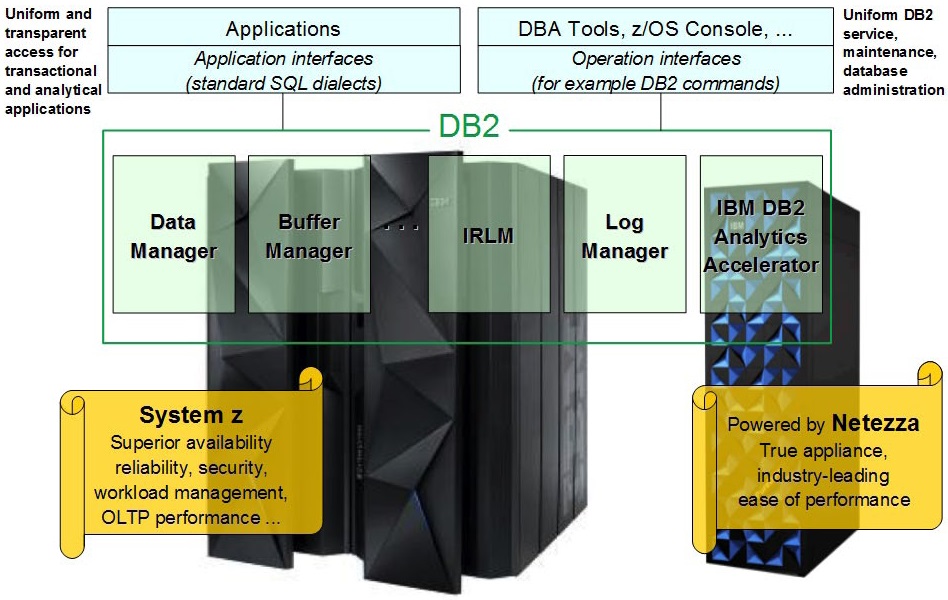Editor's Note: This article is an excerpt from The Business Value of DB2 for z/OS: IBM DB2 Analytics Accelerator and Optimizer.
Business analytics plays a crucial role in today's workplace. The performance and cost of the DB2 Analytics Accelerator opens up unprecedented opportunities for enterprises to make use of the data on the IBM System z platform. Customers have seen dramatic improvement in the response times of qualifying queries in some real, production-sized benchmarks. Running DB2 Analytics Accelerator on System z can result in some significant reductions in CPU usage. Of course, individual results will vary and depend on many other factors.
What Is Business Analytics? Timely, Accurate, and Secure Access to Business Information
Since the early days of data warehousing, the common statement from every vendor and pundit was that decision systems and transactional systems were vastly different and required separate platforms. Those days are over!
With the wealth of data available today, organizations are no longer willing to relegate information to the back office. Modern organizations are demanding access to customer purchase histories, customer behaviors, and trends of product sales at the time of contact—at the time of sale. This creates new challenges, because it is not enough for an enterprise to capture this data; the enterprise must also process and transform these massive amounts of data into actionable knowledge. And this needs to be done quickly while the information is still relevant.
Data transformed into intelligence gives you more than a window into your current operations. It provides a likely view of the future—what is just around the corner and even further down the road. It helps leaders know with confidence all that has happened, is happening, and might happen to every aspect of the enterprise. Spotting the key patterns, extracting critical insights from data, and taking latency and cost out of making and implementing the right decision is what is defining industry leaders.
The world we live in today is increasingly instrumented, interconnected, and intelligent. We are experiencing a revolution, and information is at the heart of it. Businesses that are taking advantage of this new wealth of information are able to make more intelligent decisions and are rising to the top. They're managing large volumes of information in real time, incorporating analytics and predictive modeling, pervasively collecting and sharing information across the entire value chain, and speeding time to value by delivering trusted, accurate, and timely information to the right decision-makers.
A company's survival can depend on the age of the data used to obtain an answer to critical business questions. With slow sales cycles, cutbacks, reluctant clients, and intense competition, business leaders are really feeling the heat to act and act fast, but a single bad decision today can be disastrous.
So what is the key to working smarter? It is having the right information and insight at the right time to drive smarter business outcomes. Working smarter means that your front-line business leaders receive timely information to uncover the new revenue opportunities and identify which product or service offerings are most likely to address the market requirement. It means business analysts can quickly access the right data points to evaluate key performance and revenue indicators in order to build successful corporate growth strategies. And it means corporate risk and compliance units can recognize potential regulatory, reputational, and operational risks before they become realities.
The DB2 Analytics Accelerator (Figure 1) gives your organization the speed to create the insights it needs to work smarter in this challenging environment. By putting the right answers in the hands of your decision-makers immediately, DB2 Analytics Accelerator puts your business in the best position to quickly adapt and grow to answer the questions of tomorrow.

Figure 1: IBM DB2 Analytics Accelerator
How Business Analytics Can Help Your Organization
Many organizations realize the benefits of improving business outcomes and improving decision-making. The use of business intelligence and analytic applications is well understood to help make smarter decisions, achieve better results, and gain a deeper understanding of trends, opportunities, weaknesses, and threats. Organizations want to further analyze their data to gain additional insights into their business.
Today, however, the enterprise warehouse environment of an organization is facing many challenges. One such challenge is that the amount of data being stored in a typical warehouse environment is increasing. As the amount of data increases and sometimes the format of this data changes, the warehouse and end-user experience can be affected. It can become challenging for an organization to see the right information in an appropriate format and in the right timeframe for use in its analysis and decision-making process. Moving large amounts of data from disparate source systems to a warehouse can be a resource-intensive task. The increasing amount of data in some warehouses can also further affect any longer-running queries and reports that might exist in an organization. These slow-running queries, when executed with other mixed online transaction processing (OLTP) and online analytical processing (OLAP) workloads, can negatively affect the experience of existing users and cause further lack of acceptance for potential new users. Combine this with typical corporate priorities to become more productive, agile, and innovative, and it becomes more challenging to deliver on the promises of data warehousing and business analytics.
For many organizations, the concept that some of their longer-running DB2 for z/OS queries can be routed to an accelerator for processing is a plus. These queries may be in the form of batch SQL jobs or may be generated by means of corporate analytic and business intelligence (BI) tools—for example, ad hoc reporting from IBM Cognos BI. The query accelerator available for DB2 for z/OS, which makes use of IBM Netezza technology, can make a big difference in the execution time of an analytic and warehouse type of workload. Combining the benefits of both DB2 for z/OS (for OLTP-type queries) and DB2 Analytics Accelerator (for longer-running analysis queries) ensures that resources are shared appropriately for all warehouse users.
The DB2 Analytics Accelerator would likely benefit an organization that fits one of the following profiles:
- Wants to undertake a new reporting initiative on IBM System z to gain more insights
- Wants to consolidate disparate data to its existing System z platform while benefiting from integrated operational BI
- Wants to modernize an existing data warehouse and BI workload on System z
These types of organizations, with the appropriate workload, would likely see their elapsed time for longer-running queries being significantly reduced. They would also likely see their CPU usage on the mainframe being reduced, allowing DB2 for z/OS to focus on efficiently running their OLTP queries.














 Business users want new applications now. Market and regulatory pressures require faster application updates and delivery into production. Your IBM i developers may be approaching retirement, and you see no sure way to fill their positions with experienced developers. In addition, you may be caught between maintaining your existing applications and the uncertainty of moving to something new.
Business users want new applications now. Market and regulatory pressures require faster application updates and delivery into production. Your IBM i developers may be approaching retirement, and you see no sure way to fill their positions with experienced developers. In addition, you may be caught between maintaining your existing applications and the uncertainty of moving to something new. IT managers hoping to find new IBM i talent are discovering that the pool of experienced RPG programmers and operators or administrators with intimate knowledge of the operating system and the applications that run on it is small. This begs the question: How will you manage the platform that supports such a big part of your business? This guide offers strategies and software suggestions to help you plan IT staffing and resources and smooth the transition after your AS/400 talent retires. Read on to learn:
IT managers hoping to find new IBM i talent are discovering that the pool of experienced RPG programmers and operators or administrators with intimate knowledge of the operating system and the applications that run on it is small. This begs the question: How will you manage the platform that supports such a big part of your business? This guide offers strategies and software suggestions to help you plan IT staffing and resources and smooth the transition after your AS/400 talent retires. Read on to learn:
LATEST COMMENTS
MC Press Online